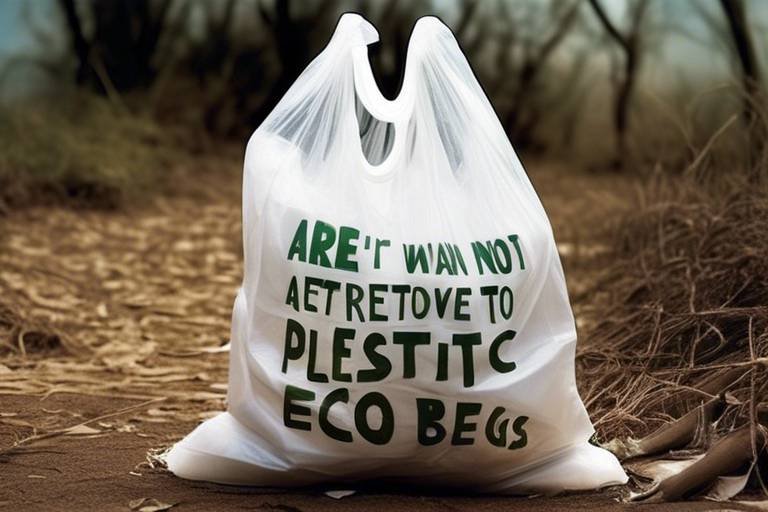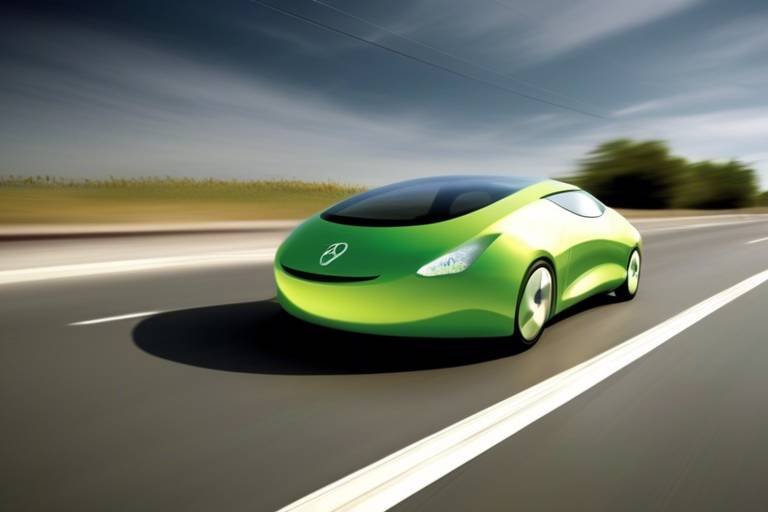Top Eco-Friendly Inventions of the Decade
This article explores groundbreaking eco-friendly inventions from the past decade that have significantly contributed to sustainability. Discover innovations that are reshaping industries and promoting a greener future for our planet.
Solar energy has transformed how we harness power, and the last decade has seen some truly remarkable advancements in this field. From solar panels that can be integrated into building materials to solar-powered vehicles, the innovations are both practical and exciting. For instance, solar roof tiles are not just functional; they blend seamlessly into your home’s design while generating energy. Imagine your roof not just protecting your home but also powering it! Not only does this reduce reliance on fossil fuels, but it also lowers electricity bills, making it a win-win for homeowners.
The rise of biodegradable materials has revolutionized packaging and product design. With the world drowning in plastic waste, these materials offer a glimmer of hope. Biodegradable alternatives, such as those made from cornstarch or mushroom mycelium, break down naturally, leaving no harmful residues. This shift is crucial for reducing plastic waste in landfills and oceans. Imagine a world where your takeaway containers decompose in weeks rather than centuries! The benefits extend beyond environmental impact; they also appeal to consumers who are increasingly eco-conscious and willing to support sustainable brands.
Electric vehicles (EVs) have gained immense popularity in the last decade, and for good reason. With advancements in battery technology, EVs are now more efficient and have longer ranges than ever before. Charging infrastructure is rapidly expanding, making it easier for consumers to switch to electric. The impact of EVs on reducing carbon emissions is substantial; they are often touted as a key solution to combat climate change. Picture this: a future where the air is cleaner, cities are quieter, and your car runs on renewable energy. That future is becoming a reality, one electric vehicle at a time.
Innovative water purification technologies are crucial for providing clean drinking water, particularly in developing regions. From solar-powered water purifiers to advanced filtration systems, these technologies are game-changers. For example, devices that use UV light to kill bacteria and viruses are becoming increasingly accessible. Imagine a simple, portable device that can turn contaminated water into safe drinking water in minutes! This not only improves health outcomes but also empowers communities by ensuring access to this vital resource.
Smart home technology plays a vital role in energy efficiency. Devices such as smart thermostats, energy monitors, and automated lighting systems help homeowners reduce energy consumption. For instance, a smart thermostat can learn your habits and adjust the temperature accordingly, saving energy without sacrificing comfort. This technology not only contributes to a more sustainable living environment but also makes life more convenient. It’s like having a personal energy manager at your fingertips!
Vertical farming has emerged as a solution to food production challenges, particularly in urban settings where space is limited. By growing crops in stacked layers, vertical farms maximize space and use significantly less water than traditional farming methods. The benefits are numerous: reduced transportation costs, fresher produce, and a smaller carbon footprint. Imagine harvesting fresh herbs or vegetables from your apartment! This innovative approach to agriculture is not just a trend; it’s a necessary evolution in how we produce food sustainably.
Energy storage solutions are essential for maximizing the use of renewable energy sources. Innovations in battery technology, such as lithium-ion and solid-state batteries, are enhancing energy efficiency and reliability. These advancements allow for better energy storage, which means that the energy generated from solar panels or wind turbines can be stored and used when needed. Think of it as a savings account for energy—storing up for a rainy day! This capability is crucial for transitioning to a more sustainable energy grid.
The fashion industry is increasingly adopting eco-friendly textiles. Sustainable materials such as organic cotton, hemp, and recycled fibers are becoming popular choices for consumers who care about the environment. Brands are also embracing ethical production practices, ensuring that workers are treated fairly. This shift is transforming clothing production and consumption, making fashion not only stylish but also responsible. Picture wearing a shirt made from recycled plastic bottles—now that’s a conversation starter!
Carbon capture technologies are vital in combating climate change. The latest advancements focus on capturing and utilizing carbon emissions rather than letting them escape into the atmosphere. From direct air capture systems that remove CO2 from the air to innovative methods that turn captured carbon into useful products, these technologies are making strides in reducing environmental impact. Imagine a world where factories not only stop polluting but actively clean the air—this is the future we’re working towards.
What are some benefits of solar-powered innovations?
Solar-powered innovations reduce reliance on fossil fuels, lower electricity bills, and contribute to a cleaner environment.
How do biodegradable materials help the planet?
Biodegradable materials break down naturally, reducing plastic waste and pollution in landfills and oceans.
What impact do electric vehicles have on carbon emissions?
Electric vehicles significantly reduce carbon emissions, especially when charged with renewable energy sources.
How can vertical farming contribute to sustainability?
Vertical farming maximizes space, uses less water, and provides fresh produce, all while reducing transportation emissions.

Solar-Powered Innovations
Solar energy has truly revolutionized the way we think about power. In the past decade, we've witnessed an explosion of innovative solar technologies that not only make renewable energy more accessible but also significantly enhance its efficiency. Imagine harnessing the sun's energy to power your home, charge your devices, and even fuel your car! It's not just a dream anymore; it's becoming a reality for many people around the globe.
One of the standout innovations in solar technology is the development of solar panels that are more efficient than ever. Traditional solar panels typically convert around 15-20% of sunlight into electricity, but advancements in materials and design have led to panels that can achieve efficiencies of over 25%. This means that homeowners can generate more power from the same amount of sunlight, making solar energy a more viable option for many.
Additionally, we are seeing the rise of solar roof tiles, which blend seamlessly with traditional roofing materials. These tiles not only provide shelter but also generate electricity, creating a two-in-one solution that is both aesthetically pleasing and functional. Imagine walking through a neighborhood where every roof is a potential power generator! This innovation is changing the landscape of residential energy consumption.
Moreover, the integration of solar energy with smart technology has opened up new possibilities. Smart solar inverters can optimize energy production by adjusting to changing weather conditions and energy demands in real-time. This means that households can maximize their solar energy usage, reducing reliance on the grid and lowering energy bills. Isn't it fascinating how technology can empower us to take control of our energy consumption?
To add another layer of excitement, solar energy is not just limited to residential use. Large-scale solar farms are popping up all over the world, producing massive amounts of clean energy that can power entire cities. These farms utilize cutting-edge technology, including solar tracking systems that adjust the angle of the panels throughout the day to follow the sun's path, maximizing energy capture.
In addition to these advancements, solar energy storage solutions have also made significant strides. The development of efficient batteries allows homeowners to store excess solar energy generated during the day for use at night. This innovation ensures that solar energy can be utilized around the clock, further enhancing its appeal. Imagine being able to power your home with clean energy even when the sun goes down!
As we look to the future, it's clear that solar-powered innovations are paving the way for a more sustainable world. With ongoing research and development, we can expect even more groundbreaking technologies to emerge, making solar energy an integral part of our daily lives. The question is, are you ready to embrace the solar revolution?
- What are solar roof tiles? Solar roof tiles are building-integrated photovoltaics that serve as both roofing materials and solar panels, generating electricity while providing protection.
- How efficient are modern solar panels? Modern solar panels can achieve efficiencies of over 25%, significantly improving energy capture compared to traditional models.
- Can solar energy be stored for later use? Yes, advancements in battery technology allow for efficient storage of solar energy, enabling usage even when the sun isn't shining.
- What are solar tracking systems? Solar tracking systems adjust the angle of solar panels throughout the day to maximize sunlight exposure and energy production.

Biodegradable Materials
In recent years, the rise of has sparked a revolution in how we think about packaging and product design. As the world grapples with the overwhelming crisis of plastic waste, these materials offer a glimmer of hope. Imagine a world where your shopping bags, food containers, and even your favorite toys decompose back into the earth instead of lingering in landfills for centuries. Biodegradable materials break down naturally, significantly reducing their environmental impact and paving the way for a more sustainable future.
So, what exactly are biodegradable materials? Simply put, they are substances that can be broken down by natural processes, primarily through the action of microorganisms. This can include everything from plant-based plastics to organic compounds derived from renewable resources. Some of the most exciting innovations in this field include:
- PLA (Polylactic Acid): Made from corn starch, PLA is a popular alternative to traditional plastics. It’s used in everything from food packaging to disposable cutlery.
- Mycelium: This fascinating material is derived from fungi and can be grown into packaging forms that are not only biodegradable but also compostable.
- Seaweed-based materials: Companies are now creating packaging from seaweed, which is abundant and grows quickly, making it a sustainable resource.
The benefits of using biodegradable materials extend beyond just reducing plastic waste. They also offer a chance to support local economies by sourcing materials from regional agricultural products. This not only helps in reducing transportation emissions but also encourages sustainable farming practices. Moreover, as consumers become more eco-conscious, businesses that adopt biodegradable options can enhance their brand image and attract a loyal customer base.
However, it's essential to note that not all biodegradable materials are created equal. Some require specific conditions to break down effectively, such as industrial composting facilities, which may not be available in all areas. Therefore, public awareness and infrastructure development are crucial in maximizing the potential of these materials. The transition to biodegradable options is not just a trend; it's a necessary shift in our approach to consumption and waste management.
In conclusion, biodegradable materials represent a significant step towards a greener planet. They embody the idea that we can create products that are not only functional but also kind to our environment. As technology advances and more sustainable alternatives become available, we can look forward to a future where our everyday items contribute to the health of our planet, rather than detract from it.
Q: What are biodegradable materials?
A: Biodegradable materials are substances that can be broken down by natural processes, primarily through the action of microorganisms, into natural elements.
Q: Are biodegradable materials always environmentally friendly?
A: While biodegradable materials are designed to reduce waste, their environmental impact can vary. Some require specific conditions to break down, which may not be available everywhere.
Q: Can biodegradable materials be recycled?
A: It depends on the type of biodegradable material. Some can be recycled, while others are designed to decompose and should not be mixed with traditional recycling streams.

Electric Vehicles
Electric vehicles (EVs) have truly taken the world by storm over the last decade, transforming the way we think about transportation. No longer just a niche market for eco-conscious individuals, EVs have become a mainstream choice for consumers seeking to reduce their carbon footprint and embrace sustainable living. With advancements in technology, the appeal of electric cars has skyrocketed, and it's not hard to see why. Imagine driving a vehicle that not only saves you money on fuel but also contributes to cleaner air and a healthier planet. Sounds like a win-win, right?
One of the most significant factors driving the popularity of electric vehicles is the rapid development of battery technology. Modern EVs are equipped with high-capacity batteries that provide longer ranges, making them more practical for everyday use. For instance, many new models can travel over 300 miles on a single charge, which is comparable to traditional gasoline vehicles. This breakthrough has alleviated the common concern of "range anxiety," where drivers worry about running out of power on long trips.
Additionally, the expansion of charging infrastructure has played a crucial role in the growth of the EV market. Charging stations are popping up in urban areas, highways, and even shopping centers, making it easier for drivers to recharge their vehicles. In fact, according to recent statistics, the number of public charging stations has increased by over 60% in just a few years. This surge in availability means that charging an electric vehicle is becoming as simple as finding a gas station.
But it's not just about convenience; the environmental impact of electric vehicles is monumental. By switching from gasoline to electric, we can significantly reduce greenhouse gas emissions. According to the Environmental Protection Agency (EPA), EVs produce, on average, half the emissions of traditional vehicles over their lifetime, even when factoring in the emissions from electricity generation. This shift is essential for combating climate change and promoting a sustainable future.
Moreover, many governments around the world are incentivizing the adoption of electric vehicles through tax credits, rebates, and other benefits. These incentives make it more affordable for consumers to make the switch, further accelerating the transition to cleaner transportation. For example, in the United States, buyers can receive a federal tax credit of up to $7,500, depending on the model of the vehicle.
As we look to the future, the electric vehicle market is only expected to grow. Major automotive manufacturers are investing billions in EV technology, with plans to release a wide range of electric models in the coming years. This competition will likely lead to even more innovations, making electric vehicles more accessible and affordable for everyone.
In summary, the rise of electric vehicles is a testament to human ingenuity and our commitment to a sustainable future. With advancements in battery technology, expanding charging infrastructure, and supportive government policies, EVs are becoming an integral part of our daily lives. So, whether you're a seasoned EV enthusiast or just curious about making the switch, there's no better time to embrace this green revolution.
- What are the main benefits of electric vehicles? Electric vehicles offer numerous benefits, including lower operating costs, reduced greenhouse gas emissions, and a quieter driving experience.
- How long does it take to charge an electric vehicle? Charging times vary depending on the charger type. A standard home charger may take 4-8 hours, while fast chargers can recharge an EV in about 30 minutes.
- Are electric vehicles more expensive than traditional cars? While the initial purchase price of electric vehicles can be higher, government incentives and lower fuel and maintenance costs often make them more economical in the long run.

Water Purification Technologies
In a world where clean drinking water is becoming increasingly scarce, the importance of innovative water purification technologies cannot be overstated. Over the past decade, remarkable advancements have emerged, addressing the urgent need for accessible and safe drinking water, especially in developing regions. Imagine a world where every drop of water is not only pure but also accessible to everyone. That's the dream, and we're getting closer every day!
One of the standout technologies in this field is the use of solar water purification systems. These systems harness the power of the sun to purify water, making them incredibly sustainable and cost-effective. By utilizing solar energy, these devices can operate in remote areas where electricity is a luxury. They work by heating water to a boiling point, effectively killing bacteria and other pathogens, and then condensing the steam back into liquid form. This process not only provides clean water but also reduces reliance on fossil fuels.
Another exciting innovation is the development of membrane filtration technology. This method utilizes specially designed membranes to filter out contaminants at a microscopic level. By employing various types of membranes, including microfiltration, ultrafiltration, and reverse osmosis, this technology can remove particles, bacteria, and even dissolved salts from water. The versatility of membrane filtration makes it suitable for various applications, from household water purification systems to large-scale municipal treatment plants.
Furthermore, nanotechnology is revolutionizing water purification. Scientists are developing nanomaterials that can effectively remove pollutants from water at an unprecedented scale. For instance, nanoparticles can target heavy metals and organic compounds, binding to them and facilitating their removal. This technology not only enhances the efficiency of water treatment processes but also significantly reduces the time required to achieve safe drinking water standards.
In addition to these technologies, bio-sand filters have gained popularity, particularly in rural areas. These simple yet effective filters use layers of sand and gravel to remove pathogens and suspended solids from water. They are low-cost, easy to maintain, and can provide a sustainable solution for communities lacking access to advanced purification systems. The beauty of bio-sand filters lies in their simplicity; they can be made from locally available materials and require no electricity to operate.
As we explore these various water purification technologies, it’s essential to recognize their potential impact on global health. According to the World Health Organization, approximately 2 billion people lack access to safe drinking water. By implementing these innovative solutions, we can help bridge this gap and ensure that clean water is a fundamental right for everyone.
To summarize, the advancements in water purification technologies are not just about providing clean water; they are about creating a sustainable future. Whether it’s through solar-powered systems, membrane filtration, nanotechnology, or bio-sand filters, the innovations of the past decade are paving the way for a world where clean water is no longer a privilege but a standard. As we continue to invest in and develop these technologies, we move closer to a future where everyone has access to safe and clean drinking water.
- What are the most common methods of water purification? The most common methods include boiling, filtration, distillation, and chemical disinfection.
- How does solar water purification work? Solar water purification uses sunlight to heat water, killing pathogens and condensing steam back into liquid form.
- What is membrane filtration? Membrane filtration uses specialized membranes to filter out contaminants from water at a microscopic level.
- Can nanotechnology improve water purification? Yes, nanotechnology can enhance the efficiency of water treatment processes by targeting and removing pollutants.
- What are bio-sand filters? Bio-sand filters are simple devices that use layers of sand and gravel to remove pathogens and solids from water.

Smart Home Devices
In today's fast-paced world, are not just a trend; they are becoming an essential part of our daily lives. Imagine walking into your home and having the lights automatically adjust to your preferred brightness, the thermostat set to the perfect temperature, and your favorite music playing softly in the background. Sounds like a scene from a futuristic movie, right? Well, that future is now, and it's all thanks to innovative technology that promotes energy efficiency and sustainability.
One of the most exciting aspects of smart home devices is their ability to monitor energy consumption. Devices such as smart thermostats and smart plugs allow homeowners to track their energy usage in real-time. This not only helps in reducing energy bills but also encourages more mindful consumption. For instance, a smart thermostat can learn your schedule and adjust the heating or cooling accordingly, ensuring that energy isn't wasted when you're not home. This technology can lead to significant reductions in energy usage—up to 15% on heating and cooling costs!
Moreover, the integration of smart lighting systems can transform how we illuminate our homes. These systems can be programmed to turn off when no one is in the room or dim during certain hours, reducing electricity consumption. Imagine a world where you never have to worry about leaving the lights on again! Additionally, some smart lights can even be controlled via smartphone apps or voice commands, making them incredibly convenient.
Another remarkable innovation is the use of smart appliances. From refrigerators that can monitor food freshness to washing machines that optimize water usage, these devices are designed to be eco-friendly while making our lives easier. For example, a smart washing machine can determine the appropriate amount of water needed based on the load size, which not only conserves water but also saves energy. This means you can do your laundry guilt-free, knowing you’re making a positive impact on the environment.
With the rise of the Internet of Things (IoT), the connectivity of these devices has reached new heights. Homeowners can now control their devices remotely, ensuring that they can manage their energy consumption even when they are away. This is particularly beneficial for individuals with busy lifestyles, as it allows for flexibility and efficiency. Imagine being able to turn off your appliances from your office or set your coffee maker to brew just before you get home!
However, it’s essential to consider the security aspects of smart home devices. While they offer convenience, they can also pose risks if not properly secured. Always ensure that your devices are updated with the latest software and that you use strong passwords. By taking these precautions, you can enjoy the benefits of smart home technology without compromising your safety.
In conclusion, smart home devices are revolutionizing the way we interact with our living spaces. They not only enhance our comfort but also play a crucial role in promoting energy efficiency and sustainability. As we continue to embrace these innovations, we are taking significant steps towards a greener future. So, why not start exploring the smart home revolution today?
- What are smart home devices? Smart home devices are electronic devices that connect to the internet and can be controlled remotely, often enhancing energy efficiency and convenience.
- How do smart home devices save energy? They monitor and optimize energy usage, allowing homeowners to reduce waste and lower their energy bills.
- Are smart home devices secure? While they can pose security risks, using strong passwords and keeping software updated can help mitigate these risks.
- Can I control smart home devices remotely? Yes, most smart home devices can be controlled via smartphone apps or voice commands from anywhere.

Vertical Farming
Vertical farming is not just a trend; it's a revolutionary approach to agriculture that holds the key to solving some of the most pressing food production challenges we face today. Imagine a world where fresh produce is grown in skyscrapers, using minimal land and resources. This innovative farming method allows us to cultivate crops in stacked layers, often integrated into urban environments. By utilizing controlled-environment agriculture (CEA) technology, vertical farms can optimize plant growth while significantly reducing the need for pesticides and herbicides. It’s like having a mini-ecosystem right in the heart of the city!
One of the most exciting aspects of vertical farming is its ability to produce food closer to where it's consumed. This drastically cuts down on transportation emissions and ensures that consumers have access to fresher produce. In fact, studies have shown that vertical farms can reduce the carbon footprint associated with traditional farming methods by up to 90%. Imagine the impact this could have on our environment!
Vertical farms also utilize advanced technologies such as hydroponics and aeroponics, which allow plants to grow without soil. Instead, they rely on nutrient-rich water solutions or mist to nourish their roots. This method not only conserves water—using up to 90% less than conventional farming—but also allows for year-round production, regardless of external weather conditions. It's like having a greenhouse that’s always in season!
Moreover, vertical farming can contribute to urban sustainability by transforming unused spaces into productive agricultural areas. Abandoned warehouses, rooftops, and even shipping containers can be repurposed for growing food. This not only beautifies urban landscapes but also promotes local economies and food security. To illustrate this, here’s a quick overview of the benefits of vertical farming:
| Benefit | Description |
|---|---|
| Space Efficiency | Maximizes food production in limited urban spaces. |
| Water Conservation | Uses significantly less water compared to traditional farming. |
| Reduced Carbon Footprint | Minimizes transportation emissions by growing food locally. |
| Year-Round Production | Enables consistent crop yields regardless of seasonal changes. |
As we embrace this innovative farming technique, it’s important to consider the potential challenges as well. While vertical farming has numerous advantages, it also requires significant upfront investment in technology and infrastructure. Additionally, the energy consumption for lighting and climate control can be a concern. However, with the rise of renewable energy sources, many vertical farms are beginning to integrate solar panels and other green technologies to offset these costs.
In conclusion, vertical farming represents a promising solution to the challenges of modern agriculture. It not only offers a sustainable way to produce food but also enhances urban living and reduces our environmental impact. As technology continues to evolve, we can expect vertical farming to play an increasingly vital role in feeding the growing global population while preserving our planet for future generations.
- What is vertical farming? Vertical farming is an innovative agricultural practice that involves growing crops in stacked layers, often in controlled environments, to maximize space and efficiency.
- How does vertical farming save water? Vertical farming uses hydroponic and aeroponic systems that require up to 90% less water compared to traditional farming methods.
- Can vertical farms operate year-round? Yes, vertical farms can produce crops year-round, regardless of external weather conditions, thanks to controlled environment technologies.
- What are the environmental benefits of vertical farming? Vertical farming reduces transportation emissions, conserves water, and minimizes land use, contributing to a lower carbon footprint.

Renewable Energy Storage
The quest for sustainable energy is not just about generating power; it's equally about storing it efficiently. As we increasingly rely on renewable sources like solar and wind, the need for effective solutions has never been more critical. Imagine a world where the sun shines bright during the day, but your energy needs persist into the night. How do we bridge that gap? This is where innovative storage technologies come into play, ensuring that the energy harnessed today can be utilized tomorrow.
One of the most exciting advancements in this field is the development of lithium-ion batteries. These batteries have become the backbone of modern energy storage systems, powering everything from electric vehicles to home energy storage solutions. Their efficiency and decreasing costs have made them more accessible than ever. According to recent studies, the price of lithium-ion batteries has dropped by over 80% in the past decade, making them a viable option for widespread use. This means that households and businesses can invest in battery systems that store excess energy generated from their solar panels, providing a steady power supply even when the sun isn’t shining.
But lithium-ion batteries are just the tip of the iceberg. Other innovative technologies are emerging, such as flow batteries, which offer longer discharge times and can be scaled up easily for larger applications. These batteries work by pumping electrolyte solutions through a cell, allowing for greater energy storage capacity without the limitations of traditional batteries. Moreover, researchers are exploring the potential of solid-state batteries, which promise higher energy densities and improved safety features, making them an exciting prospect for the future.
In addition to batteries, pumped hydro storage remains one of the oldest and most effective methods for large-scale energy storage. This technology uses excess energy to pump water uphill to a reservoir. When energy is needed, the water is released to flow downhill, turning turbines to generate electricity. It’s like having a giant battery in the form of a mountain! Despite its effectiveness, the geographical limitations of pumped hydro can restrict its implementation in certain regions.
Another innovative approach gaining traction is compressed air energy storage (CAES). This method compresses air in underground caverns during times of low energy demand and then releases it to generate electricity when demand peaks. It’s a fascinating blend of physics and engineering that showcases how we can harness natural resources creatively. In fact, a recent project in Germany has demonstrated the potential of CAES to provide grid stability and balance supply and demand effectively.
As we look toward the future, the integration of renewable energy storage systems into our energy grid will be paramount. Not only will it enhance the reliability of renewable energy sources, but it will also contribute significantly to reducing our carbon footprint. Imagine cities powered entirely by renewable energy, with storage systems ensuring that power is available whenever it’s needed. It’s not just a dream; it’s a vision that is rapidly becoming a reality.
To sum up, the advancements in renewable energy storage technologies are paving the way for a more sustainable future. From lithium-ion batteries to pumped hydro and compressed air systems, the innovations are diverse and promising. As these technologies continue to evolve, they will play a crucial role in our transition to a greener, more resilient energy landscape.
- What are the main types of renewable energy storage? The main types include lithium-ion batteries, flow batteries, pumped hydro storage, and compressed air energy storage.
- Why is renewable energy storage important? It allows us to store excess energy generated from renewable sources, ensuring a reliable power supply even when production is low.
- How do batteries improve renewable energy use? Batteries store energy for later use, helping to balance supply and demand and reduce dependence on fossil fuels.
- Are there any limitations to renewable energy storage? Yes, limitations can include geographical constraints for certain technologies and the current cost of advanced storage solutions.

Eco-Friendly Textiles
In recent years, the fashion industry has undergone a significant transformation, with a growing emphasis on sustainability. Eco-friendly textiles are at the forefront of this movement, offering innovative solutions that not only reduce environmental impact but also enhance the quality of our clothing. Imagine wearing a shirt made from organic cotton or a jacket crafted from recycled plastic bottles. These materials are not just trendy; they represent a profound shift in how we think about fashion and its relationship with our planet.
One of the most exciting developments in eco-friendly textiles is the use of organic fibers. Unlike conventional cotton, which relies heavily on pesticides and fertilizers, organic cotton is grown without harmful chemicals. This not only benefits the environment but also ensures that the cotton is safer for the farmers who cultivate it. Additionally, fabrics made from hemp and bamboo have gained popularity due to their rapid growth and minimal resource requirements. These materials are not only biodegradable but also incredibly durable, making them perfect for everyday wear.
Another fascinating area is the rise of recycled materials. Brands are increasingly turning to post-consumer waste to create new textiles. For instance, polyester made from recycled plastic bottles has become a staple in many clothing lines. This process not only diverts plastic waste from landfills but also reduces the need for virgin materials, significantly lowering the carbon footprint associated with production. Imagine the impact if more brands adopted this approach; we could see a dramatic decrease in plastic pollution while still enjoying stylish, high-quality clothing.
Moreover, the concept of circular fashion is gaining traction. This approach encourages consumers to think about the lifecycle of their clothing. Instead of merely discarding garments, the focus is on recycling and upcycling. Some companies even offer programs where customers can return old clothes in exchange for discounts on new purchases. This not only promotes sustainability but also fosters a sense of responsibility among consumers, making them active participants in the eco-friendly movement.
As we delve deeper into the world of eco-friendly textiles, it’s essential to consider the broader implications of these innovations. The fashion industry is notorious for its wastefulness, but with the advent of sustainable materials and practices, there is a glimmer of hope. By choosing eco-friendly options, consumers can drive demand for sustainable practices, encouraging more brands to follow suit. This shift not only benefits the environment but also supports ethical labor practices, as many sustainable brands prioritize fair treatment of workers.
To illustrate the impact of eco-friendly textiles, consider the following table showcasing some popular materials and their benefits:
| Material | Benefits |
|---|---|
| Organic Cotton | Grown without pesticides; safer for farmers and the environment. |
| Hemp | Fast-growing, requires little water, and is biodegradable. |
| Recycled Polyester | Reduces plastic waste; lowers carbon footprint. |
| Bamboo | Renewable resource; naturally antibacterial and biodegradable. |
In conclusion, the rise of eco-friendly textiles is not just a passing trend; it represents a fundamental change in the way we approach fashion. By prioritizing sustainability, we can enjoy stylish clothing while contributing to a healthier planet. The next time you shop for clothes, consider the materials and their origins. Your choices can make a difference, paving the way for a more sustainable future in fashion.
Q1: What are eco-friendly textiles?
A1: Eco-friendly textiles are materials that are produced with minimal environmental impact, often using sustainable practices and resources. This includes organic fibers, recycled materials, and biodegradable fabrics.
Q2: Why are eco-friendly textiles important?
A2: They help reduce pollution, conserve resources, and promote sustainable practices within the fashion industry, ultimately contributing to a healthier planet.
Q3: How can I identify eco-friendly clothing?
A3: Look for certifications such as GOTS (Global Organic Textile Standard) for organic materials or brands that prioritize sustainable practices and transparency in their supply chains.
Q4: Are eco-friendly textiles more expensive?
A4: While some eco-friendly options may have a higher upfront cost, they often provide better durability and quality, making them a worthwhile investment in the long run.

Carbon Capture Technologies
In the relentless battle against climate change, have emerged as a beacon of hope. These innovative solutions are designed to capture carbon dioxide emissions from sources like power plants and industrial processes, preventing them from entering the atmosphere. Imagine a world where we can literally trap the harmful gases we produce and repurpose them into something beneficial. Sounds like science fiction, right? But it’s happening now!
One of the most exciting aspects of carbon capture is its potential to significantly reduce greenhouse gas emissions. According to recent studies, implementing these technologies could remove billions of tons of CO2 from the atmosphere each year. This could be a game-changer in our fight against global warming. The technology works by using various methods, such as chemical solvents, membranes, and even biological processes, to capture carbon dioxide. Once captured, the CO2 can be stored underground or utilized in various applications, such as creating synthetic fuels or even in the production of concrete.
Let's dive deeper into the different types of carbon capture technologies:
| Technology Type | Description | Applications |
|---|---|---|
| Post-combustion Capture | Removes CO2 from flue gases after fossil fuels are burned. | Power plants, industrial processes. |
| Pre-combustion Capture | Captures CO2 before combustion occurs, often in gasification processes. | Hydrogen production, integrated gasification combined cycle (IGCC) plants. |
| Direct Air Capture | Captures CO2 directly from the ambient air using chemical processes. | Carbon offsetting, negative emissions technologies. |
Each of these technologies plays a crucial role in reducing carbon emissions. For instance, post-combustion capture is particularly significant because it can be retrofitted to existing power plants, making it a viable option for industries looking to reduce their carbon footprint without completely overhauling their systems. On the other hand, direct air capture is a fascinating approach that targets CO2 already present in the atmosphere, offering a way to actively reverse some of the damage we've done.
However, despite the promising potential of carbon capture technologies, there are challenges to overcome. The costs associated with capturing and storing carbon can be high, and there are concerns about the long-term storage of CO2. What happens if the storage sites leak? These questions are essential as we strive to implement these technologies on a larger scale.
Moreover, the success of carbon capture technologies hinges on the support from governments and industries alike. Incentives, regulations, and funding are crucial to drive innovation and adoption. Without a concerted effort, we risk letting these groundbreaking technologies remain underutilized.
As we look to the future, the integration of carbon capture technologies into our energy systems could pave the way for a more sustainable world. Imagine cities powered by clean energy, where emissions are captured and reused, contributing to a circular economy. It’s not just a dream; it’s a possibility that we can achieve if we continue to innovate and invest in these technologies.
- What is carbon capture technology? Carbon capture technology refers to methods and processes that capture carbon dioxide emissions from sources like power plants to prevent it from entering the atmosphere.
- How does carbon capture work? It works by using various techniques to capture CO2, which can then be stored underground or used in different applications.
- Is carbon capture technology effective? Yes, it has the potential to significantly reduce greenhouse gas emissions, but its effectiveness depends on widespread adoption and technological advancements.
- What are the challenges of carbon capture? The primary challenges include high costs, potential leakage from storage sites, and the need for government support and infrastructure.
Frequently Asked Questions
- What are some examples of solar-powered innovations?
Solar-powered innovations include solar panels that are now more efficient than ever, solar-powered chargers for devices, and even solar-powered vehicles. These advancements make it easier for individuals and businesses to harness the sun's energy, reducing reliance on fossil fuels.
- How do biodegradable materials help the environment?
Biodegradable materials break down naturally, reducing the amount of plastic waste that ends up in landfills and oceans. By using alternatives like plant-based plastics or compostable packaging, we can significantly lessen our ecological footprint and promote a healthier planet.
- What advancements have been made in electric vehicle technology?
Electric vehicles (EVs) have seen improvements in battery life, charging speed, and overall efficiency. With the expansion of charging infrastructure and the development of more affordable models, EVs are becoming a viable option for more consumers, helping to cut down on carbon emissions.
- Why are water purification technologies important?
Water purification technologies are crucial for ensuring access to clean drinking water, especially in areas where water quality is compromised. Innovations like portable water filters and advanced purification systems can provide safe drinking water, improving health outcomes and quality of life.
- What role do smart home devices play in sustainability?
Smart home devices help monitor and manage energy consumption, making it easier for homeowners to reduce their energy usage. From smart thermostats that optimize heating and cooling to energy-efficient appliances, these technologies contribute to a greener living environment.
- How does vertical farming contribute to sustainable agriculture?
Vertical farming allows for food production in urban areas, utilizing less land and water than traditional farming methods. By growing crops in stacked layers and often using hydroponics or aeroponics, vertical farms can reduce transportation emissions and provide fresh produce to city dwellers.
- What innovations exist in renewable energy storage?
Innovations in renewable energy storage include advanced battery technologies like lithium-ion and solid-state batteries, as well as other methods such as pumped hydro storage. These technologies help store excess energy generated from renewable sources, ensuring a reliable power supply even when the sun isn't shining or the wind isn't blowing.
- What are eco-friendly textiles, and why are they important?
Eco-friendly textiles are made from sustainable materials like organic cotton, hemp, or recycled fibers. They are important because they reduce the environmental impact of the fashion industry, which is notorious for pollution and waste. By choosing sustainable fabrics, consumers can support ethical practices and reduce their carbon footprint.
- How do carbon capture technologies work?
Carbon capture technologies capture carbon dioxide emissions from sources like power plants and industrial processes. The captured CO2 can then be stored underground or reused in various applications, helping to mitigate the effects of climate change and reduce greenhouse gas emissions in the atmosphere.



















